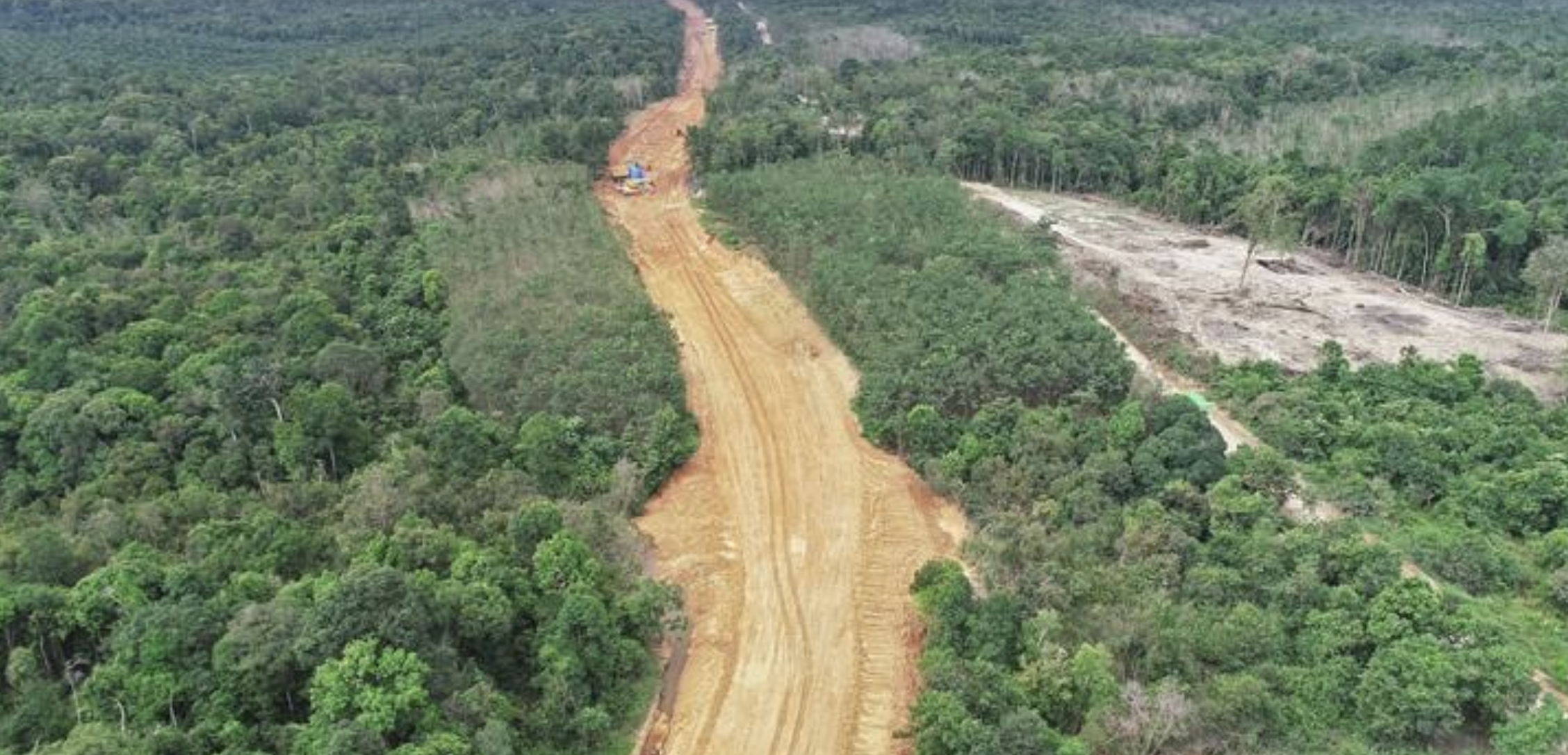
This is part 1 of 5 of Tempo Magazine's August 3rd edition cover story.
Minister of Environment and Forestry Siti Nurbaya Bakar gave the subsidiary of Rajawali Corpora, owned by tycoon Peter Sondakh, the permit to build a road for transporting coal in Harapan Forest in Jambi and South Sumatra. Before issuing the permit, Minister Siti even went as far as revising a regulation that would have prohibited building the road
The Harapan Forest restoration area, which is a natural habitat for Sumatra's endemic animals, will be split by the 26-kilometer-long and 60-meter-wide road. Besides destroying trees in the secondary forest, at a value of over Rp400 billion, the mining road will also threaten biodiversity and indigenous communities, and will open the opportunity for illegal loggers to enter the restored production forest.
DURING a visit to Jambi as a campaigner for the National Democrat (NasDem) Party, Minister of Environment and Forestry Siti Nurbaya Bakar summoned Governor Fachrori Umar and forestry office chief, Ahmad Bestari. At the time, on April 4, 2019, political parties were campaigning for the legislative election. As a Jambi NasDem cadre, Fachrori welcomed Siti in the VVIP lounge of the Sultan Thaha Airport. He was accompanied by Bestari because Siti had asked him to discuss forest management in the province. According to two sources aware of the meeting, after lunch they began their conversation about the fires that frequently ran rampant in Jambi's forests.
Many topics were discussed, including the plan to build a mining road in the Harapan Forest, which lies in the two provinces of Jambi and South Sumatra. In the 98,555-hectare area, there are industrial plantation forests (HTI), oil palm plantations, and coal mines. To transport its yield for export, concession holding companies would have to haul their goods for 133 kilometers through the Bayung Lencir River port.
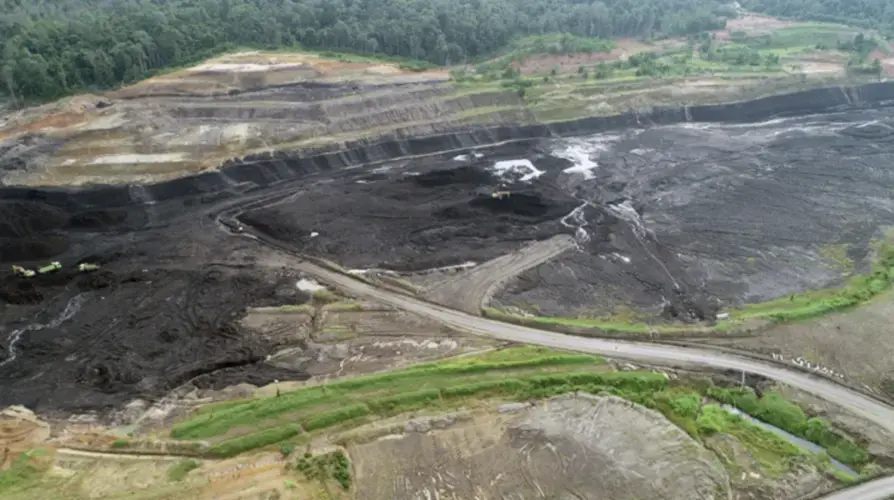
The distance is considered to be burdensome. Plus, the current road is too narrow and in poor condition, which means transporting coal and oil palm takes three days. Through its sub-subsidiary, Rajawali Corpora-a mining company operating in the forest — applied for a permit to build a new 26-kilometer road across Harapan Forest.
Siti asked the two officials about the requirements for issuing a forest area utilization permit (IPPKH) for building a mining road. Fachrori explained that they would not be able to issue a recommendation because it would conflict with Environment and Forestry Ministerial Regulation No. 27/2018 on IPPKH guidelines. Minister Siti had used this regulation to revise an earlier regulation allowing coal mining roads to be built in ecosystem restoration forest areas.
Bestari confirmed the meeting. He remembers welcoming Minister Siti at Sultan Thaha Airport, and that he was then invited to lunch with Governor Fachrori. After that, he was excused to leave because Siti's next schedule was a NasDem Party campaign event. As a civil servant, Bestari was not allowed to join a political party event.
PERMIT POST-REVISION
The permit for a mining road in Harapan Forest was issued after the obstructing regulation was revised. Many recommendations were brushed aside.
December 20, 2012
The forestry ministry invites Restorasi Ekosistem Indonesia to meet with Musi Mitra Jaya, that wishes to build a road in the restoration area.
May 16, 2013
Restorasi rejects the plan to build a road because it would disrupt the forest ecosystem.
July 12, 2017
Triaryani requests a recommendation for an IPPKH (forest area utilization permit) from South Sumatra and Jambi governors.
September 14, 2017
Triaryani transfers the permit request to Marga Bara Jaya.
October 26, 2017
South Sumatra governor issues a recommendation letter for building a road for Marga Bara Jaya.
May 21, 2018
Environment and forestry ministry's research, development, and innovation agency recommends avoiding building a mining road in the restoration area because it would cause fragmentation. If a transportation route has to be created, a conveyor must be used.
July 13, 2018
The forestry ministry revises Regulation No. 50/2016 by forbidding mining road development in a restoration area under Regulation No. 27/2018.
February 20, 2019
The central AMDAL assessment committee rejects the plan to build a mining road in Harapan Forest.
February 21, 2019
Environment Minister Siti Nurbaya revises Regulation No. 27/2018 into Regulation No. 7/2019, which again allows a mining road to be built in a restoration area.
March 27, 2019
An AMDAL assessment committee meeting again stresses its rejection of the plan to build a mining road in the restoration area.
April 4, 2019
Minister Siti Nurbaya asks Jambi governor and chief of Jambi forestry office to issue a recommendation for a mining road.
April 26, 2019
Ministerial Regulation No. 7/2019, which allows mining road development in a restoration area, comes in effect.
August 13, 2019
Jambi and South Sumatra governors issue a recommendation for Marga Bara Jaya for building a mining road in Harapan Forest.
October 17, 2019
Minister Siti Nurbaya issues a permit for the road.
Neither did Bestari deny the topic of his discussion with Minister Siti. But he refused to answer our question as to whether Siti asked him to immediately write a recommendation for building a coal mining road for Rajawali Corpora. “No comment,” he said in late June. The fact is, Jambi governor's recommendation for the road was issued on August 13, 2019.
According to Bestari, the obstructing regulation, namely Minsiterial Regulation No. 27/2018, was revised by Siti on April 26, 2019. She inserted a new clause under article 12, allowing an IPPKH to be used for a road for transporting coal. “If the regulation allows it, what basis do we have for refusing it?" asked Bestari.
What Bestari did not know was that Minister Siti had, in fact, revised the regulation two months before they met at Sultan Thaha Airport. Minister of Environment and Forestry Regulation No. 7/2019 was signed on February 21, 2019, to come into effect two months later. Siti refused to answer questions about the event’s chronology, including her meeting with Governor Fachrori and Bestari. “I don't wish to answer,” she said after the Idul Adha (Day of Sacrifice) prayer at the environment and forestry ministry on Friday, July 31.
She repeated the same answer three times for different questions. She refused to provide any answer for questions having to do with the permit for building a mining road in Harapan Forest, which she issued on October 17, 2019, three days before the end of her first-term tenure as forestry minister. The permit she issued shattered the rejection of various groups who felt that a mining road would disrupt Harapan Forest's ecosystem - including the recommendation of the environment and forestry ministry's research, development, and innovation agency.
***
Marga Bara Jaya was given the permit to build a road for mining. Upon tracing the company's share ownership, the chain of ownership ended with Rajawali Corpora, a parent company owned by tycoon Peter Sondakh. Rajawali has shares in Karya Loka Persada, Marga Bara Rahardja’s direct parent company. It is this company that owns 99.9 percent of Marga Bara Jaya's shares.
In actuality, the company was handed over the permit request process by Triaryani. The coal mining company in North Musi Rawas, South Sumatra, is also a subsidiary of Rajawali Corpora. Triaryani stopped applying for a permit to clear the forest due to rejections from Restorasi Ekosistem Indonesia, which holds Harapan Forest's restoration concession-indigenous communities, a civil society coalition, as well as the regional governments of Jambi and South Sumatra.
Triaryani took over the permit request to build a road from Musi Mitra Jaya, the operating company for the current road, which is narrow and long. Musi leases the road to numerous mining, oil palm, and industrial forest companies and collects a fee. Rejection from various groups against building a road in Harapan Forest caused Musi to back down from the permit application in 2012.
Adiosyafri, Hutan Kita Institute research and campaign director, said building a mining road in an ecosystem restoration area would disrupt the biodiversity, which has grown back since Restorasi began its restoration work in 2007. Prior, the forest area was damaged and degraded after it was left by a company with an industrial forest plantation permit, Asialog.
Restorasi became the first company to manage a production forest under a restoration scheme, or a 90-year break from logging when the government created a breakthrough policy for managing the forest in 2007. The company founded by Burung Indonesia, Birdlife International, and the Royal Society for the Protection of Birds is tasked with protecting and restoring the damaged forest. Harapan Forest is an endemic habitat to Sumatra's plants and animals, such as the endangered tiger, bear, elephant, and hornbill.
Thirteen years later, a secondary forest began to grow in the forest area 1.5 times the size of Jakarta. Trees grew large with two to three meters of distance between them. Meranti (Shorea) and merbau (Intsia) as thick as the body of an adult loomed tall, with rattan surrounding them.
In June, when Tempo visited the forest, we found claw marks left behind by a sun bear that tore at a medang batu tree (Dehaasia caesia) as well as a hornbill nest on a tree, at a height of 15 meters. Restorasi's survey found that at least 1,310 trees in the forest are home to 620 animal species, 106 of which are endangered.
According to the environmental impact assessment (AMDAL) created by Marga Bara Jaya, which has been approved by the environment and forestry ministry in August 2019, the road to be built will be 40 meters wide. Taking into account the four-meter-wide drainage system to be built on each side of the road plus a six-meter wide vegetation area, the total width of the forest cut down will reach 60 meters. If the value of small and large timber is Rp600,000-1.5 million, the selling price could reach Rp436 billion.
The road would span from North Musi Rawas to Bayung Lencir for 92 kilometers. By reducing the distance, the road's transportation capacity would grow to 10 million tons of coal annually, or three times the current route. The road will also be used to transport plantation products in the amount of four million tons as well as other forest products at one million tons annually.
In North Musi Rawas, three companies are mining coal, namely, Triaryani, Gorby Putra Utama, and Barasentosa Lestari. Coal reserves in the three companies' concession areas reach one billion metric tons. The coal is exported to China and India, whose factories still operate using non-renewable energy. The spike in coal demand from the two countries is hard to meet because of the long and narrow road.
Ibrahim, Triaryani's head of external affairs, said his company has not been able to export massive amounts of coal due to the narrow road. Triaryani's 2,143-hectare concession area contains 406 million tons of coal and 257 million tons of coal reserve. “We have the largest coal reserve compared to other companies here,” he said.
He added that the current road's transportation capacity is only 400 trucks per day. Because the road is narrow and slippery, and turns muddy when it rains, coal transportation has not been optimal. Many trucks have slid off the road due to its poor condition.
Triaryani asked for the recommendations of Jambi and South Sumatra governors for clearing land to build a new mining road on July 12, 2017. A recommendation from the regional government is a requirement for requesting a permit with the environment ministry. Because Triaryani was aware of its conflict of interest, the company being a coal mining firm, it transferred the request to Marga Bara Jaya.
According to Chrismasari Dewi Sudono, secretary of Golden Eagle Energy– Triaryani's parent company-her firm does not have ties with Marga Bara Jaya. “Neither do we have a plan to build a mining road,” she said. In fact, the company's deed clearly shows the tie between the two firms, with Rajawali Corpora as their parent company.
As much as 79 percent shares in Golden Eagle Energy are owned by Mutiara Timur Pratama, while 27 percent of Mutiara's shares are owned by Rajawali Corpora. Meanwhile, almost the entirety of Marga Bara Jaya's shares are owned by Marga Bara Rahardja. Rahardja's shareholder is Karya Loka Persada, Rajawali Corpora's subsidiary.
The transfer tactic proved to be successful. Within just one month, the South Sumatra governor issued a recommendation for Marga Bara Jaya. Only Jambi governor's recommendation was left. Jambi Forestry Office Chief of Forest Utilization, Edmon Edwar, said they were unsure about issuing the recommendation due to the ambiguity of Environment Ministerial Regulation No. 50/2016 on the IPPKH.
Edmon quoted Article 12 clause 1a, which forbids an IPPKH to be issued to overlap with a restoration permit. But according to clause 2, an IPPKH for a mining road is permissible as long as it does not disrupt biodiversity. Because he had doubts regarding the two clauses, Edmon wrote to the environment and forestry ministry directorate-general of forest and environmental planning (PTKL). “The PTKL allowed it, but not a road. A conveyor instead,” he said.
PTKL's recommendation is in line with the study by the ministry's research, development, and innovation agency. The agency's recommendation states that building a mining road would cause the forest to be fragmented, threatening its biodiversity. “Fragmentation's impact would cause large animal populations to be
split into small populations, which are more vulnerable to local extinction,” says the agency's recommendation.
Because of the rejection against building the road and the recommendation, a meeting by the central AMDAL Assessment Commission on February 20, 2019, made three alternatives for a mining road to Bayung Lencir. The Harapan Forest was mentioned as one alternative. Another alternative was to follow the contour of the forest's border, and the last option was to build a road outside the restoration area, which would pass through an industrial plantation forest area. “I was among those who refused (to build) a mining road in the restoration area because the regulation prohibited it,” said Jambi Forestry Office Chief, Ahmad Bestari.
The three alternatives were, in fact, old options. At least, industrial plantation forest concession holders had received offers to work together in building a mining road, to ease the transportation of forest, plantation and coal products. One businessman, for example, said Peter Sondakh attempted to lobby Abdul Hali aka Haji Halim.
In South Sumatra, Haji Halim is famous as a major businessman. Through the Sentosa Group, he owns various concessions for oil palm and rubber plantations, coal, as well as industrial plantation forest. Several state officials, including President Joko Widodo and former President Susilo Bambang Yudhoyono, visited the 82-year-old businessmen during their visit to South Sumatra.
Sentosa Group's plantation forest area borders Harapan Forest. According to the AMDAL map, the area would have been passed by the third road alternative. Several people close to Hajim Halim say he met with Peter Sondakh in 2017 in Jakarta to talk about the mining road. Haji Halim agreed to have his concession area split by a road, as long as he would be given shares in Marga Bara Jaya. The news is that Peter Sondakh did not agree to such requirement.
Haji Halim refused to confirm the story. When met at his large home in Palembang, South Sumatra, he explained at length about his forest concession, plantation business, and the coal mining road. But he refused to have his statements quoted, including when he was asked to confirm his meeting with General Moeldoko to discuss the mining road.
Moeldoko was a commander of the Indonesian Military (TNI) in 2013-2015. In 2014, he appointed Peter Sondakh as his economic advisor. In 2018, President Jokowi appointed Moeldoko as Presidential chief of staff. Moeldoko claims he never met with Haji Halim. “I don't know Haji Halim,” he said. Meanwhile, Peter Sondakh has not responded to Tempo's request for an interview. An interview request letter sent to his office in Menara Rajawali, Mega Kuningan, went on unanswered.
The not-so-smooth negotiation between Haji Halim and Peter Sondakh caused the third alternative to meet a dead end. On April 12, 2019, Marga Bara Jaya applied for a permit with two alternatives: to split Harapan Forest right down in the middle or rather to the side. Both alternatives would lie in the restoration area.
Again the two alternatives were rejected by the civil society coalition during an AMDAL evaluation commission meeting three months later. The coalition still asked to have the road built outside the restoration area. Because of the stalemate, the commission gave two route options to the environment minister: outside or inside the Harapan Forest concession area. Minister Siti Nurbaya had already made her decision: the permit would be given for a mining road inside the Harapan Forest ecosystem restoration area, which would take over 400 hectares of the forest. According to the AMDAL map, the route chosen by Minister Siti is in line with the second route.
Minister Siti brushed aside the consideration that the route would lie on the crossing trails of large animals endemic to Sumatra. The mining road permit was issued on October 17, 2019, three days before the end of her first-term tenure.
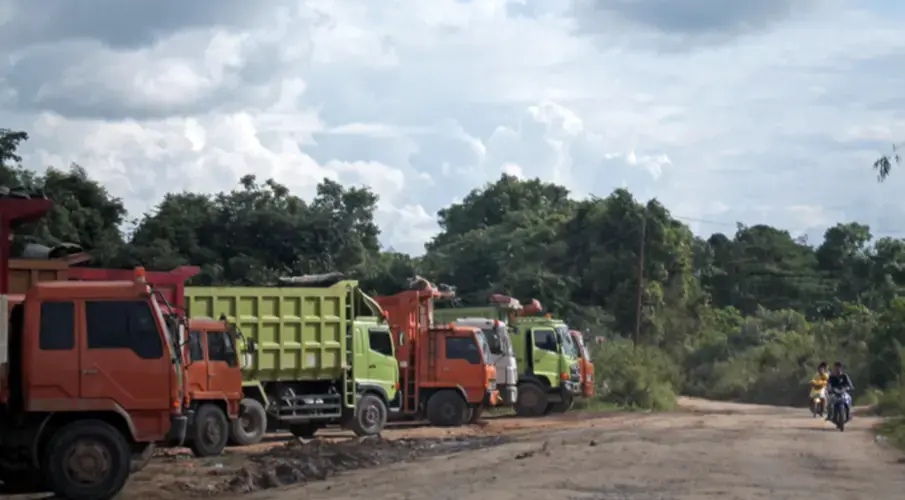
The obstructing Ministerial Regulation No. 27/2018, which she created to forbid building a mining road in a restoration area, was revised into regulation No. 7, which came into effect in April 2019 and gave an exception for an IPPKH in a restoration area. Government Regulation No. 6/2017 on forest planning and management planning as well as forest utilization, which forbids overlapping permit was turned into a mere 'caution'. “According to legal logic, it can't be done,” said Rudi Syaf, executive director of the environmental group Warsi Indonesian Conservation Community.
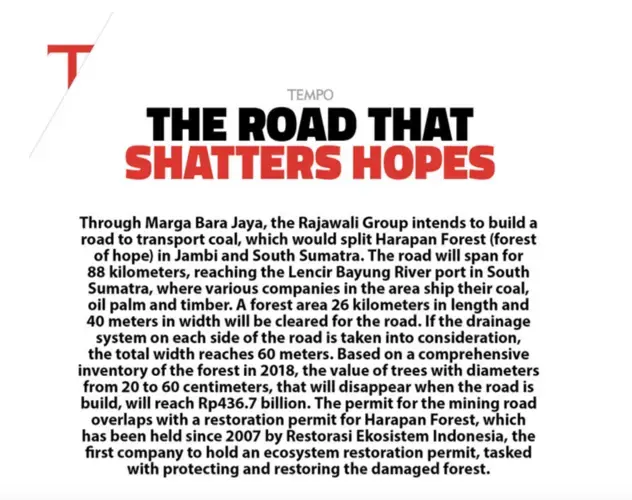
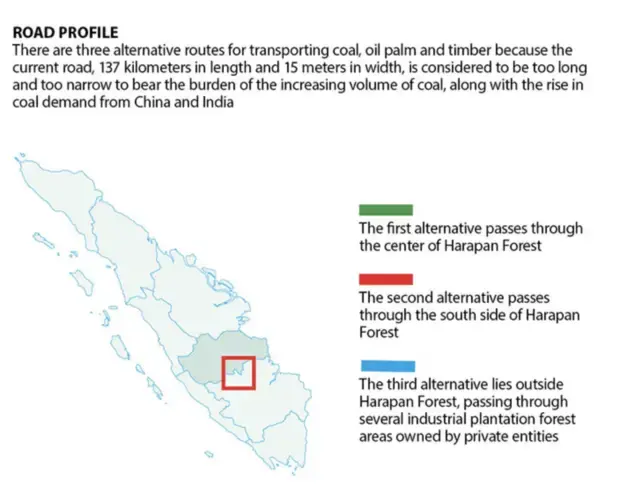
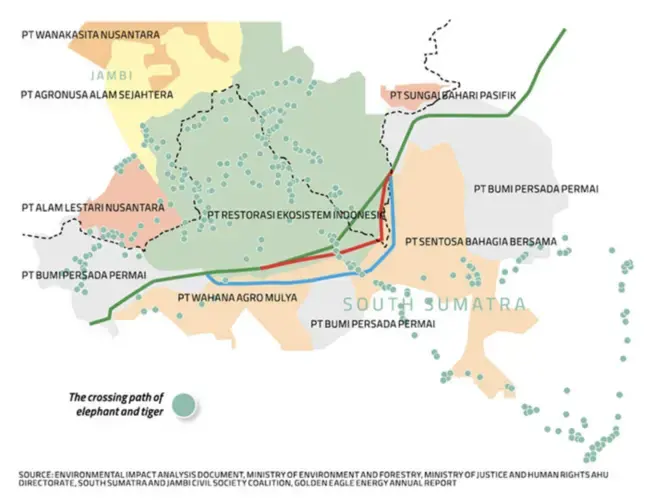
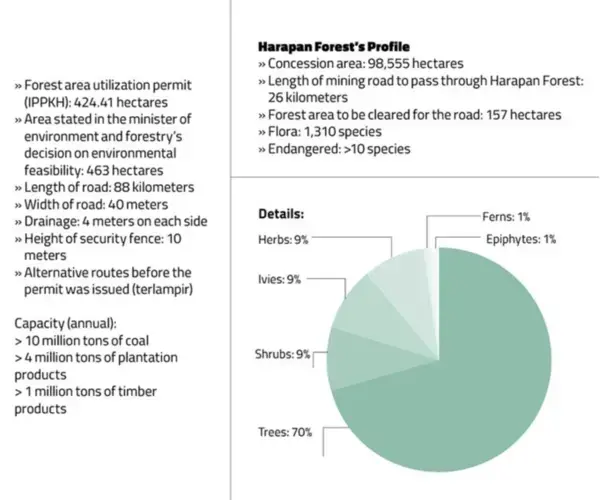
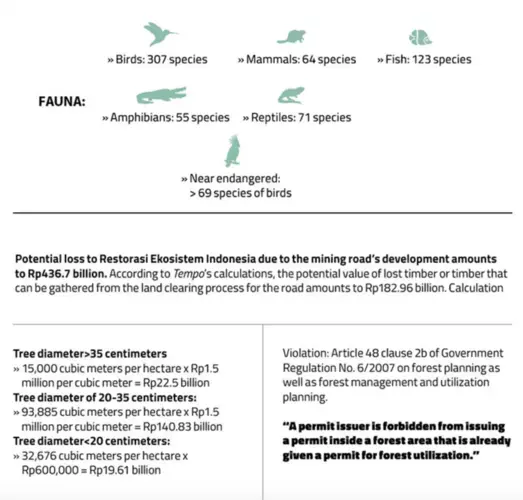
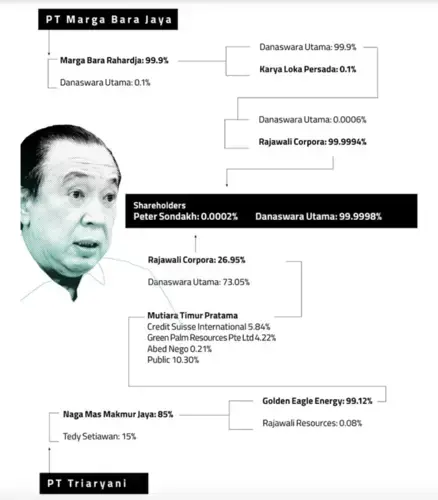
Environment and Forestry Decision Letter No. SK.816/Menlhk/Setjen/PLA.0/10/2019 is a permit for the second alternative mining road, which is three kilometers toward the outer territory of Harapan Forest. Here, meranti, merbau and medang batu trees the size of an adults abdomen grow. Restorasi has not been officially forwarded the decision letter. “I only heard that the mining road's permit has been issued,” said Mangara Silalahi, Restorasi's Chief Executive Officer.
The Coalition of Anti-Destruction of Forest in South Sumatra-Jambi calculated the potential lost timber caused by the road to reach Rp5.5 trillion. Not to mention the loss of endangered animal species that will be disrupted by machines used for clearing the land. Environment and Forestry Ministry Secretary-General, Bambang Hendroyono, ensures that the road construction will be monitored to avoid disrupting Harapan Forest’s plants and animals.
According to Bambang, the road permit is already in line with procedure and takes into consideration the economic value of natural resources. “Production forests can indeed be encouraged to increase their mining potential by still considering their biodiversity, social and economic potentials,” he said.






